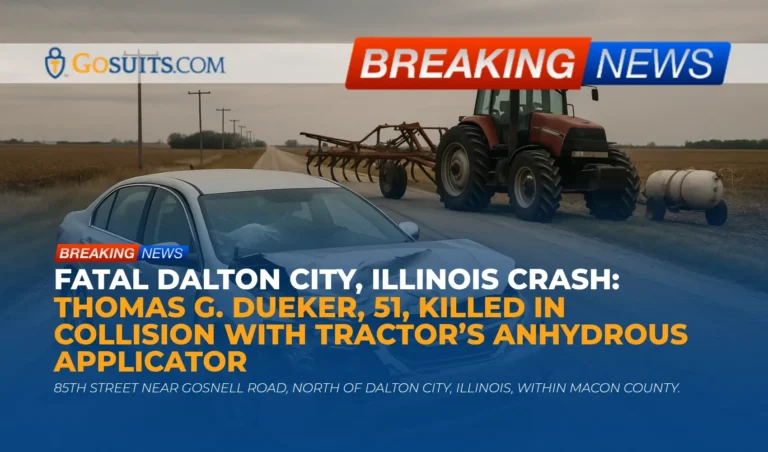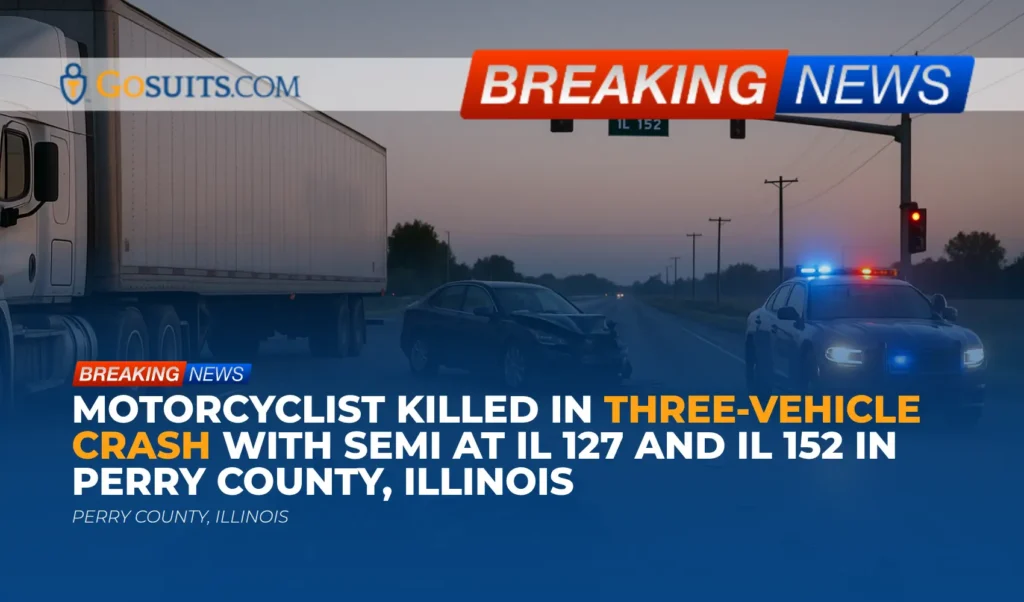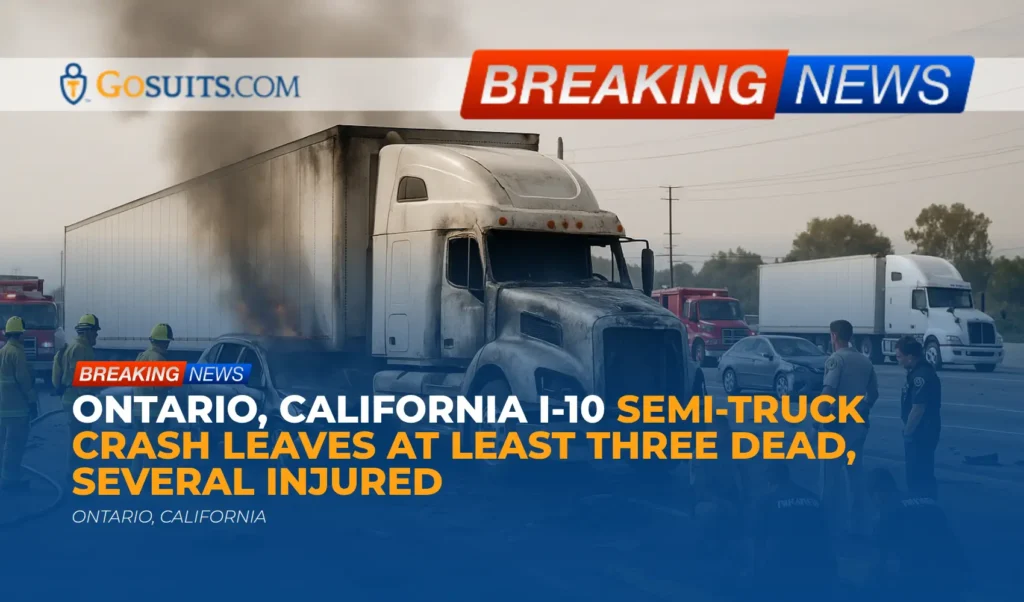- Overview of the reported crash north of Dalton City, Illinois
- What authorities have reported so far
- Safety context for rural roads during harvest season
- Farm equipment on public roads: obligations and risks
- Anhydrous ammonia equipment: what to know for public safety
- How crash investigations typically proceed after a fatal roadway incident
- Potential civil liability and insurance considerations
- Rights of surviving family members in Illinois
- Time limits and key deadlines
- Practical steps to protect a potential claim
- Where to obtain official records and information
- Community safety takeaways for sharing the road
- Commentary from Gosuits Dalton City, Illinois Personal Injury Attorney
- Why taking action now matters
Overview of the reported crash north of Dalton City, Illinois
Authorities responded to a fatal collision on 85th Street near Gosnell Road, north of Dalton City, Illinois. According to initial reports, a tractor towing an anhydrous tank was traveling southbound when a northbound vehicle driven by a 51-year-old Tuscola resident, Thomas G. Dueker, collided with the tractor’s extended anhydrous applicator. Mr. Dueker was pronounced deceased at the scene. Officials indicated the anhydrous tanks remained intact, and there was no hazardous materials release reported. The tractor operator received a citation for improper lane usage, and the Macon County State’s Attorney is reviewing the investigation for any additional action. The sheriff’s office reminded drivers to exercise caution on rural roads during harvest season, noting reduced daylight and colder conditions can affect visibility and vehicle control.
This article offers context about rural-road and farm-equipment collisions, outlines how investigations typically unfold, and explains civil legal and insurance considerations families often face after a sudden loss. It also lists reliable public resources for obtaining official records and additional information.
What authorities have reported so far
Key facts from the scene
- Location: 85th Street near Gosnell Road, north of Dalton City, Illinois, within Macon County.
- Vehicles/equipment involved: A farm tractor towing an anhydrous tank and a northbound passenger vehicle.
- Sequence described: The northbound vehicle collided with the tractor’s extended anhydrous applicator.
- Outcome: The driver of the passenger vehicle, a 51-year-old from Tuscola, was pronounced deceased at the scene.
- Hazards: The anhydrous tanks remained intact, and authorities reported no immediate hazardous conditions from the tanks.
- Citation: The tractor operator was cited for improper lane usage. The Macon County State’s Attorney is reviewing investigative findings.
Public statements also urged caution on rural roads during harvest season due to reduced daylight hours, equipment operating at lower speeds, and weather that can affect road traction and visibility.
Safety context for rural roads during harvest season
Rural roads present distinct risks compared with urban streets, especially during harvest months when large agricultural equipment uses public roadways. Nationally, fatal crashes on rural roads remain disproportionately high relative to traffic volume. Federal analyses note that rural roadway environments often involve higher speeds, narrower lanes, and reduced lighting, all of which can increase crash severity. For broader context on rural roadway risk, see the U.S. Department of Transportation’s rural road safety resources via the Federal Highway Administration at highways.dot.gov/safety/rural.
In Illinois, farm machinery commonly travels between fields on county or township roads during harvest. These vehicles are typically slower, wider, and may have attachments that extend beyond a typical passenger car’s profile. University extension programs regularly emphasize the importance of increased following distances, reduced speeds when approaching equipment, and cautious passing. For community education materials on sharing the road with farm equipment, see the University of Illinois Extension’s farm safety resources at extension.illinois.edu.
Additionally, CDC/NIOSH studies continue to identify roadway incidents involving agricultural equipment as a persistent hazard in agricultural regions. For data and prevention strategies in agricultural roadway safety, see CDC/NIOSH Agricultural Safety.
Farm equipment on public roads: obligations and risks
Farm tractors and implements of husbandry are legally permitted to use public roads for short distances, such as traveling between fields. Illinois law defines “implement of husbandry” in the Illinois Vehicle Code at 625 ILCS 5/1-130. While these vehicles may have exemptions from certain equipment requirements, they must still be operated with due care and in a manner that does not unreasonably endanger other road users.
Common risk factors unique to farm equipment on the road include:
- Width and extensions: Attachments such as planters, sprayers, or anhydrous applicators can extend laterally, sometimes beyond lane lines if not properly retracted or managed. This can create unexpected encroachments into opposing traffic.
- Speed differential: Tractors often travel well below posted speed limits, leading to rapid closure rates and reduced reaction time for approaching motorists.
- Visibility and lighting: At dawn, dusk, or in overcast weather, the visibility of equipment can be diminished. Markings, reflectors, and lighting become crucial. University extension and state transportation safety guidance consistently encourage high-visibility markings and proper lighting to alert other drivers.
- Road geometry: Narrow lanes, soft shoulders, and sharp curves common on rural roads can leave little margin for error when wide attachments are present.
These factors make it especially important for both farm equipment operators and motorists to follow cautionary practices such as reducing speed, avoiding sudden passing maneuvers, and maintaining ample space when approaching or overtaking equipment. While each collision is fact-specific, encroachment across the center line or occupying more than a lane’s width without adequate warnings or precautions can raise questions about negligence in a civil case.
Anhydrous ammonia equipment: what to know for public safety
In this incident, officials reported that the anhydrous tanks remained intact and did not pose a hazardous materials release at the scene. That matters because anhydrous ammonia is a highly corrosive, cryogenic hazardous substance that can cause severe chemical burns and respiratory injury if released. OSHA provides general safety information regarding anhydrous ammonia handling and storage at osha.gov/anhydrous-ammonia.
Even without a chemical release, the physical profile of anhydrous equipment can present unique roadway challenges:
- Extended applicators: Applicators may extend several feet beyond the tractor’s body, which can intrude into the path of oncoming traffic if not properly centered within the lane.
- Trailer dynamics: Towed tanks can track differently than the tractor on narrow roads, especially on curves or uneven surfaces, increasing the risk of lateral movement near the center line.
- Visibility of attachments: If lighting or reflectors on the far outer edges of wide attachments are limited, opposing drivers may underestimate the equipment’s width.
Recognizing these factors is important for both community safety and for understanding how investigators assess roadway dynamics following such a crash.
How crash investigations typically proceed after a fatal roadway incident
In a fatal collision, multiple agencies may be involved. In Macon County, the sheriff’s office typically leads scene response and documentation. A fatality triggers coroner involvement, and investigative coordination can include reconstruction specialists, forensic examinations, and, where applicable, reviews by prosecutorial authorities.
Typical components of a post-crash inquiry
- Scene documentation: Measurements of lane widths, skid or yaw marks, debris fields, and final rest positions are recorded. Photographs and, at times, drone mapping help preserve the layout.
- Vehicle/equipment inspections: Investigators often assess mechanical condition, lighting, reflectors, and the positioning or deployment of attachments like applicators. In farm equipment cases, attachment width and lane position relative to center lines are important.
- Electronic data: Passenger vehicles may contain event data recorders capturing speed, braking, and other parameters. Farm equipment may have telemetry or maintenance records depending on the model.
- Witness statements and environmental conditions: Investigators assess lighting, weather, roadway grade or curves, and sight lines. Rural roads with limited illumination make dusk and dawn particularly critical times.
- Coroner findings: Cause and manner of death, along with toxicology where appropriate, are part of the official record. These findings can inform both safety policy and civil litigation evaluation.
From a civil perspective, the investigation provides the foundation for understanding whether any party failed to use reasonable care, whether equipment was operated within lane confines, and whether visibility or warnings were adequate under the conditions.
Potential civil liability and insurance considerations
While final determinations depend on all evidence, the civil law evaluates conduct under a reasonableness standard. If any vehicle or equipment operator failed to keep proper lane position or operate with due care, that can constitute negligence and potentially create civil liability. Important civil concepts in Illinois include:
- Comparative fault: Illinois follows a modified comparative negligence rule. A claimant’s recovery can be reduced by their percentage of fault and is barred if their fault exceeds 50 percent. See 735 ILCS 5/2-1116.
- Vicarious liability: If a farm employee was operating the tractor in the course of work, the farm business or owner may be responsible for the operator’s negligence under agency principles.
- Equipment and maintenance issues: Claims sometimes consider whether lighting, reflectors, slow-moving vehicle emblems, or width indicators were reasonably used and maintained. Statutory definitions for farm equipment appear in the Illinois Vehicle Code at 625 ILCS 5/1-130; general lighting and roadway operation duties are evaluated along with the broader duty to use reasonable care.
- Roadway and signage conditions: In rare cases, design or maintenance issues can be assessed, but claims involving public entities require careful evaluation due to statutory immunities and strict notice requirements.
Insurance layers often implicated
- Personal auto liability: The auto policy for the passenger vehicle may provide coverage for certain losses, depending on fault allocations.
- Farm/commercial liability: Farm policies may cover liability arising from equipment operation on public roads. There may also be commercial auto or umbrella policies.
- Uninsured/underinsured motorist (UM/UIM): In some cases, a decedent’s own policy could provide UM/UIM benefits if a liable party’s coverage is insufficient.
Insurance carriers will request statements and documents quickly. People often do not realize that what is said to any insurer can be recorded and later used in ways that affect a civil case. It is prudent to speak with a qualified attorney first, so that rights are understood before any insurance communication occurs.

Rights of surviving family members in Illinois
When a death is caused by the wrongful act or negligence of another, Illinois law permits certain claims on behalf of the decedent and the surviving family.
- Wrongful Death claim: Brought for the benefit of the surviving next of kin to compensate for losses such as grief, loss of companionship, and loss of support. See the Illinois Wrongful Death Act at 740 ILCS 180.
- Survival claim: Brought on behalf of the decedent’s estate to recover damages the decedent could have claimed if they had lived, such as conscious pain and suffering and medical expenses. Illinois’ Survival Act is codified at 755 ILCS 5/27-6.
The existence and value of these claims depend on evidence, applicable insurance, and the individual circumstances of the crash. Families often need clear guidance on how these claims differ and how they are pursued through the probate process.
Time limits and key deadlines
Statutes of limitations are strict deadlines that govern when claims must be filed. In Illinois:
- Wrongful Death: Generally, actions must be filed within two years of the death, with some exceptions for specific circumstances. See 740 ILCS 180/2.
- Personal injury (nonfatal): Typically two years from the date of injury under 735 ILCS 5 provisions.
Other deadlines may apply for claims involving governmental entities or certain insurance coverages. Because evidence can degrade and records requests take time, prompt attention is important.
Practical steps to protect a potential claim
In the aftermath of a fatal collision, it can be difficult to know where to begin. The following steps are general suggestions to help preserve important information and avoid common pitfalls. These are not case-specific instructions but educational points about process and timing.
- Consult an attorney before speaking to insurance companies: Insurance representatives may ask for recorded statements. What is said can be used later in ways that affect a civil claim. Speaking with an attorney first can help ensure rights are protected and communications are appropriately managed.
- Preserve key documents: Retain any notices, letters, or emails from insurers, law enforcement, or medical providers. Keep a log of contacts and dates.
- Identify potential evidence early: Photographs of the scene, roadway markings, vehicle damage, and any visible equipment features (such as applicator position or lighting) can be important. If you have photos or are aware of witnesses, make a note of them.
- Request official records: Police reports, coroner records, and, where applicable, autopsy results provide the factual backbone of a claim. See the resources section below for how to locate these records.
- Track expenses and impacts: Funeral and burial costs, counseling, and other out-of-pocket expenses related to the loss should be documented.
- Be mindful of public statements: Social media posts or public commentary about the crash can be taken out of context. Consider delaying public postings until you have spoken with counsel.
Where to obtain official records and information
Obtaining official records helps families understand the investigative findings and establish documentation for insurance and civil matters. The following resources are publicly accessible and can guide requests for records in Macon County and the State of Illinois.
Law enforcement report
- Macon County Sheriff’s Office: Requests for incident or crash reports are typically handled through the agency’s records division. Visit the Macon County government website at maconcounty.illinois.gov and navigate to the Sheriff’s Office and Records sections for current procedures and contact details. Illinois’ Freedom of Information Act sets rules for access to public records; see 5 ILCS 140 for the statute text.
- Illinois State Police (general resources): Although this crash was handled locally, the Illinois State Police website provides statewide information on traffic safety and reporting processes at isp.illinois.gov.
Coroner and autopsy records
- Macon County Coroner’s Office: The coroner oversees medicolegal death investigations and may provide certain records or reports depending on the status of the investigation and applicable privacy rules. To locate contact information and request procedures, use the county’s official site at maconcounty.illinois.gov and navigate to the Coroner’s Office page.
- Death certificates: Certified copies may be requested through the Illinois Department of Public Health’s Vital Records. See IDPH guidance at dph.illinois.gov/topics-services/birth-death-other-records/death-records.html.
Prosecutorial coordination
- Macon County State’s Attorney: For questions about the status of any prosecutorial review of a fatal crash investigation, refer to the Macon County government site at maconcounty.illinois.gov and navigate to the State’s Attorney page for contact information. While the criminal process is separate from civil claims, timing and findings can overlap with civil evaluations.
Note that some records may not be immediately available if an investigation is ongoing. Agencies may also require formal requests or fees. The Illinois FOIA statute at 5 ILCS 140 outlines general rights of access, timelines, and exemptions.
Community safety takeaways for sharing the road
Community members often ask what can be done to reduce the likelihood of crashes like this. Safety is a shared responsibility. The following are general, research-informed reminders drawn from agricultural safety and roadway safety guidance.
- Anticipate wide attachments: When you see a tractor or towed tank ahead, assume the equipment may be wider than the lane or may track differently on curves.
- Slow down early: High speed differentials reduce reaction time. Gradually reduce speed and avoid abrupt lane changes near farm equipment.
- Increase following distance: Give yourself a larger safety cushion to react to turns into field drives or unexpected stops.
- Pass only when safe and legal: Make sure there is clear sight distance and room to pass without encroaching into the path of an opposing vehicle. Be mindful that equipment may turn left into a field without a conventional turn bay.
- Equipment operators should maximize visibility: Use appropriate lighting and reflectors, ensure slow-moving vehicle signage where applicable, and retract or manage attachments to remain within lane boundaries as conditions allow.
For further prevention guidance tailored to Illinois’ agricultural communities, see educational materials from the University of Illinois Extension at extension.illinois.edu, and national agricultural roadway safety information through CDC/NIOSH. Broader rural roadway safety programs are described by the U.S. DOT’s FHWA at highways.dot.gov/safety/rural.

Commentary from Gosuits Dalton City, Illinois Personal Injury Attorney
Our hearts go out to those affected by this tragic collision north of Dalton City. Losing a loved one suddenly on a rural roadway is devastating, and we extend our sincere sympathies. The information here is offered for general educational purposes to help the community understand the civil-law and safety context that often accompanies farm-equipment crashes.
Based on the information released so far, investigators reported a collision with an extended anhydrous applicator and cited the tractor operator for improper lane usage. In the civil context, lane position, equipment width, visibility, and speed differentials are critical issues. When any piece of equipment occupies part of the opposing lane or presents an unexpected lateral hazard, it raises serious questions about roadway management and reasonable safety measures under the circumstances. That said, civil liability determinations depend on a full assessment of evidence, including roadway geometry, lighting, and conduct of all parties involved.
Insurance carriers and, at times, corporate or farm-operation risk managers move quickly after serious crashes. They may seek recorded statements or early agreements before a full picture is developed. It is not always apparent to grieving families that such communications can shape how fault is later argued. Insurers are experienced at using early statements, partial records, and technical policy language to limit exposure. Taking time to understand rights, coverages, and the investigative timeline can help level the playing field.
Speaking with a seasoned and skilled attorney for a free consultation before interacting with insurance companies can provide clarity about the process, help avoid missteps, and ensure that key evidence and deadlines are not overlooked. A consultation is an opportunity to ask questions, understand options, and make informed decisions without pressure.
Why taking action now matters
- Preserving evidence is time-sensitive: Tire marks fade, debris is cleared, and vehicles or equipment are repaired or returned to service. Early action helps ensure scene evidence, photos, and data are documented while they still exist.
- Records requests take time: Police, coroner, and medical records often involve processing periods, potential fees, and, sometimes, follow-up communication. Starting promptly helps prevent delays from jeopardizing important deadlines.
- Insurance communications can affect outcomes: Carriers may ask for recorded statements or medical authorizations. Understanding your rights before responding reduces the risk of unintentionally harming a potential claim.
- Deadlines are strict: Illinois statutes of limitations and notice rules can bar claims if missed. Acting early provides time to investigate, identify all responsible parties, and evaluate available insurance coverage.
- Community safety benefits: Swift reporting and documentation also support broader safety improvements by helping agencies and communities identify roadway risks and prevention strategies for rural corridors.
Additional references
- Illinois Wrongful Death Act, 740 ILCS 180
- Illinois Survival Act, 755 ILCS 5/27-6
- Comparative fault statute, 735 ILCS 5/2-1116
- Definition of implement of husbandry, 625 ILCS 5/1-130
- IDPH Vital Records: Death Certificates
- Macon County, Illinois (official site)
- Illinois State Police
- USDOT FHWA: Rural Road Safety
- CDC/NIOSH: Agricultural Safety
- OSHA: Anhydrous Ammonia
- University of Illinois Extension: Farm Safety Resources






